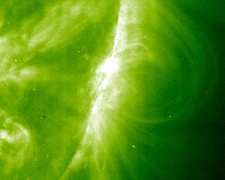|
Solar maximum is years past, yet the
sun has been remarkably active lately. Is the sunspot cycle broken?
by Dr Tony Phillips
Imagine you're in California. It's July,
the middle of summer. The sun rises early; bright rays warm the
ground. It's a great day to be outside. Then, suddenly, it begins
to snow - not just a little flurry, but a swirling blizzard that
doesn't stop for two weeks.
That's what forecasters
call unseasonal weather.
It sounds incredible,
but "something like that just happened on the sun," says David Hathaway,
a solar physicist at NASA's Marshall Space Flight Center.
Only a few weeks ago
solar activity was low. The face of the sun was nearly blank - "very
few sunspots," says Hathaway - and space weather near Earth was mild.
"Mild is just what we expect at this point in the 11-year solar
cycle," he explains. "The most recent maximum was in 2001, and solar
activity has been declining ever since."
Sunspots cause solar
flares and, usually, the biggest flares come from the biggest spots.
The three giant sunspots unleashed eleven X-class flares in only
fourteen days - equaling the total number observed during the previous
twelve months. "This was a big surprise," says Hathaway.
The effects on Earth
were many: Radio blackouts disrupted communications. Solar protons
penetrated Earth's upper atmosphere, exposing astronauts and some
air travelers to radiation doses equal to a medical chest X-ray.
Auroras appeared all over the world - in Florida, Texas, Australia
and many other places where they are seldom seen.
Researchers rank solar
flares according to their x-ray power output. C-flares are the weakest.
M-flares are middling-strong. X-flares are the most powerful. Each
category has subdivisions: e.g., X1, X2, X3 and so on.
A typical X-flare registers X1 or X2. On Nov. 4th, sunspot 486 unleashed
an X28 flare - the most powerful ever recorded.
"In 1989 a flare about
half that strong caused a widespread power blackout in Quebec,"
recalls Hathaway. The blasts of a fortnight ago were aimed away
from Earth, so its effects on our planet were slight - a bit of
good luck.

more
An
extreme-ultraviolet telescope onboard the orbiting Solar
and Heliospheric Observatory (SOHO) captured this false-color
movie of the Nov. 4, 2003, X28 superflare near the sun's
limb
|
All this happened two
years after solar maximum, which raises a question: is
something wrong with the solar cycle? Is the sun going haywire?
"Nothing's wrong,"
reassures Hathaway. The sun isn't about to explode, nor is the sunspot
cycle broken. "These latest sunspots were whoppers," he allows,
"but sunspot counts averaged over many weeks are still declining
as predicted. We're still on course for a solar minimum in 2006."
Indeed, it's possible
that what we've just experienced is a normal part of the solar cycle,
speculates Hathaway. "There's a curious tendency for the biggest
flares to occur after solar maximum - on the downslope toward solar
minimum. This has happened during two of the last three solar cycles."
The plot below illustrates his point.
Consider the year 1984,
says Hathaway. Sunspot counts were plunging, and the sun was rapidly
approaching the 1985-86 solar minimum. Suddenly a giant sunspot
appeared, Jupiter-sized like sunspot 486, and unleashed two dozen
M-flares and three X-flares, including a remarkable flare registering
X13. People then probably wondered too if the solar cycle was broken.
"It's hard to be sure
what's normal and what's not," notes Hathaway. "Astronomers have
been observing x-rays from the sun for only 35 years - or three solar
cycles. We can't draw good statistical conclusions from so few data."
One thing is certain,
though: flurries of solar activity can happen at any time. The next
time, says Hathaway, could be close.
Sunspot 486 and its
companions are on the far side of the sun now, carried around by
the sun's 27-day rotation. "We suspect they're still active," says
Hathaway, because the Solar and Heliospheric Observatory - a sun-watching
satellite - has photographed clouds of gas being thrown over the
sun's limb by unseen explosions.
And then...? No one
knows. "We might get some more unseasonal space weather," says Hathaway.
But this time he won't be surprised.
|